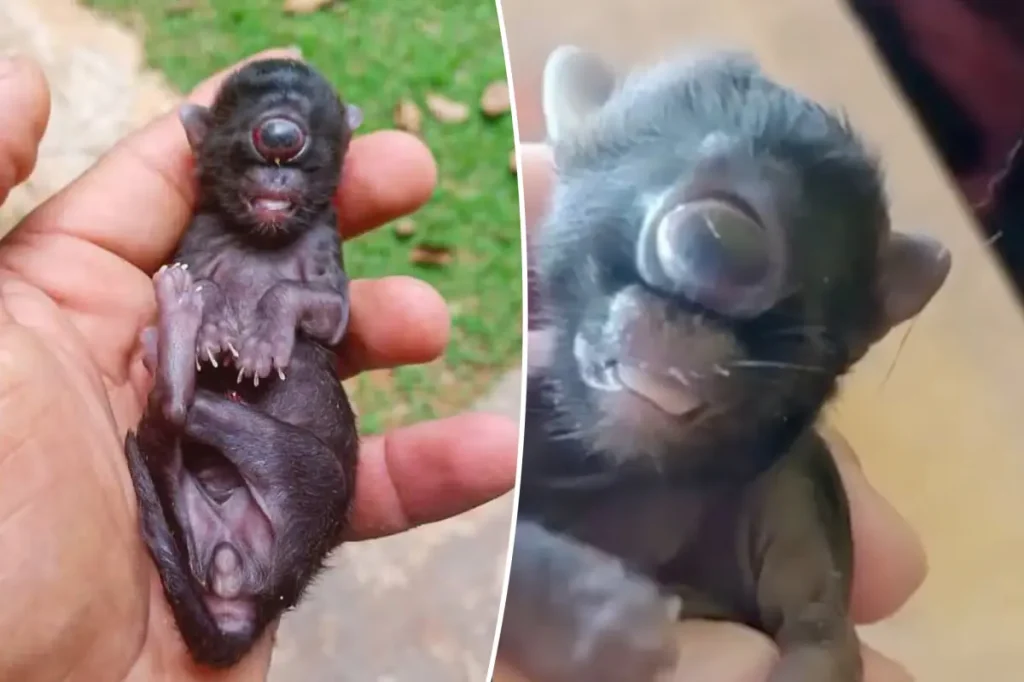A Rare Phenomenon: The Story of Brazil’s “Cyclops Cat”
In a small farm in Vilhena, located in Brazil’s Rondonia state, an extraordinary event occurred that captivated both locals and internet users worldwide. On November 4, a black kitten was born with a single eye centered on its face, a phenomenon so rare that it left even its caretaker, 32-year-old farmhand Gilberto Almeida, in awe. “I’m 32 years old and I’ve never seen anything like this in my life,” Almeida shared with NewsX. “My cat has had several litters, but this was the first time something like this happened.” The kitten, quickly dubbed the “cyclops cat,” was one of four born in the litter but stood apart with its unique appearance that seemed almost otherworldly. The image of Almeida holding the small black kitten revealed a creature so unusual that many viewers initially thought it might be digitally created rather than a natural occurrence.
The striking appearance of the kitten stemmed from cyclopia, a rare congenital disorder named after the one-eyed giants of Greek mythology. Veterinarian Janete Silva explained the biological mechanism behind this condition: “When the embryo is developing, instead of the brain structure dividing into two parts, a single mass forms. As the eye follows this division, it ends up positioned in the center.” This developmental anomaly affects the normal formation of facial features during embryonic growth, resulting in the characteristic single eye positioned in the middle of the face. While the condition creates a visually striking appearance, it typically comes with severe health implications that affect the creature’s ability to survive outside the womb.
Indeed, the rarity of cyclopia is matched only by its severity. Medical literature indicates that the condition occurs in fewer than one in 100,000 births across species, making the Brazilian kitten a truly exceptional case. The condition isn’t limited to animals – humans can also develop cyclopia, typically resulting from chromosomal abnormalities or exposure to certain medications during pregnancy. The complex developmental processes that form the face and brain during gestation can be disrupted by various factors, leading to this unusual presentation. In most documented cases across species, the condition proves fatal shortly after birth due to the associated complications, particularly those affecting the respiratory system.
This was unfortunately true for the cyclops kitten from Brazil as well. Despite the initial fascination with its unique appearance, the kitten’s life was brief and challenging. Just over a day after its birth, on November 6, the kitten passed away due to breathing difficulties – a common complication for creatures born with this condition. The single-eyed appearance, while captivating, came with profound structural issues that made survival nearly impossible. In many cases of cyclopia, the pregnancy doesn’t even reach full term, often resulting in miscarriage or stillbirth. The kitten’s brief life, though, offered a rare glimpse into this unusual biological occurrence and prompted wider discussion about developmental disorders.
The story of the cyclops kitten reminds us of nature’s complexity and occasional diversions from typical developmental pathways. While the ancient Greeks might have viewed such a creature through the lens of mythology – as something godly or monstrous – modern science allows us to understand the biological mechanisms behind such rare occurrences. The condition serves as a stark illustration of how precisely choreographed normal embryonic development must be, and how even small deviations can produce dramatic results. For scientists, veterinarians, and medical professionals, such cases provide valuable insights into developmental biology, potentially contributing to broader understanding of congenital conditions across species.
Though the cyclops kitten lived for only a short time, its story continues to resonate online, where the video of Almeida holding the unusual creature has spread widely. The kitten’s appearance challenges our conventional understanding of beauty and normality, embodying the truth behind the saying that “beauty is in the eye of the beholder.” While its physical appearance might initially shock viewers, there is something profound about encountering such rare natural phenomena – they remind us of the vast diversity of life and development, even when that development follows unexpected paths. The cyclops kitten from Brazil, in its brief existence, became not just a biological curiosity but a reminder of life’s fragility and the endless variations that can emerge from nature’s complex processes.















